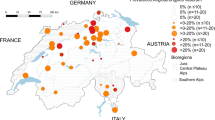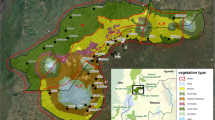Abstract
Observations have been made over a 15-month period on the frequency distribution of human faecal deposits and infective larvae ofNecator americanus in a hookworm endemic area. The agestructure of infective larvae in a field population and their vertical distribution in soils were determined. These studies were undertaken to examine the hypothesis that hookworm transmission in the tropics is discontinuous and limited mainly to the rainy season.
The distribution of larvae was found to be overdispersed statistically and in general much greater numbers of L3s were recovered during the rainy season. The degree of overdispersion was also reduced during this season, and there was a tendency for larvae to be confined to the surface/topsoil. The implications of these findings have been discussed in relation to human hookworm parasitism in endemic areas of the tropics.
Similar content being viewed by others
References
Acholonu ADW (to be published). A review of human helminthiases in Nigeria 1900–1978: 1 — Hookworm infection. J Trop Appl Biol
Anya AO, Udonsi JK (to be published) Mechanism of desiccation — survival of infective larvae ofNecator americanus. J Trop Appl Biol
Augustine DL (1923) Investigations on the control of hookworm diseaseXXIII. Experiments on the factors determining the length of infective hookworm larvae. Am J Hygiene 3:420–443
Boag B, Thomas RJ (1975) The population dynamics of nematode parasites of sheep in Northern England. Res Vet Sci 19:193–295
Crofton HD (1952) The ecology of immature stages of trichostrongyle nematodes IV. Larval populations on lowland pastures. Parasitology 42:77–84
Crofton HD (1954) The ecology of immature stages of trichostrongyle nematodes V. The estimation of pasture infestation. Parasitology 44:313–324
Croll NA (1972) Energy utilisation of infective larvae ofAncylostoma tubaeforme. Parasitology 64:355–368
Croll NA, Matthews BE (1973) Activity, ageing and penetration of hookworm larvae. Parasitology 66:279–289
Donald AD (1967) Population studies on the infective stages of some nematode parasites of sheep. I. The frequency distribution of strongloid infective larvae in random samples of pasture. Parasitology 67:263–279
Donald AD, Leslie RT (1969) Population studies on the infective stage of some nematode parasites of sheep II: The distribution of faecal deposits on fields grazed by sheep. Parasitology 59:141–157
Michel JF (1968) The epidemiology and control of nematode infections of grazing animals. Adv Parasitol 7:211–282
Nwosu ABC (1977) Evaluating the infectivity of third-stage larvae of hookworms — the importance of larval activity and lipid content. Bull Animal Health Product Africa 25:73–78
Nwosu ABC (1979) Determinants of the longevity of third-stage infective larvae ofAncylostoma tubaeforme. J. Helminthol 53:223–228
Nwosu ABC, Anya AO (1980) Seasonality in human hookworm infections in an endemic area of Nigeria and its relationship to rainfall. Tropenmed Parasitol 31:201–208
Payne FK (1923) Investigations on the control of hookworm disease XXI. The relation of the physiological age of hookworm larvae to their ability to infect the human host. Am J Hyg 3:584–597
Rogers WP (1939) The physiological ageing of ancylostome larvae. J Helminthol 17:195–202
Southcott WH, Major GW, Barger IA (1976) Seasonal pasture contamination and availability of nematodes for grazing sheep. Aust J Agric Res 27:277–286
Tallis, Donald AD (1964) Models for the distribution on pasture of infective larvae of the gastrointestinal nematode parasites of sheep. Aust J Biol Sci 17:504–513
Thomas RJ (1959) Field studies on the seasonal incidence ofNematodirus battus andNematodirus filicollis in sheep. Parasitology 49:387–410
Wallace HR (1956) Migration of nematodes. Nature 177:287–288
Wallace HR (1961) The bionomics of free-living stages of zooparasitic and phytoparasitic nematodes — a critical survey. Helminthol Abstr 30:1–22
Author information
Authors and Affiliations
Rights and permissions
About this article
Cite this article
Udonsi, J.K., Nwosu, A.B.C. & Anya, A.O. Necator americanus: Population structure, distribution, and fluctuations in population densities of infective larvae in contaminated farmlands. Z. Parasitenkd. 63, 251–259 (1980). https://doi.org/10.1007/BF00931987
Received:
Issue Date:
DOI: https://doi.org/10.1007/BF00931987




